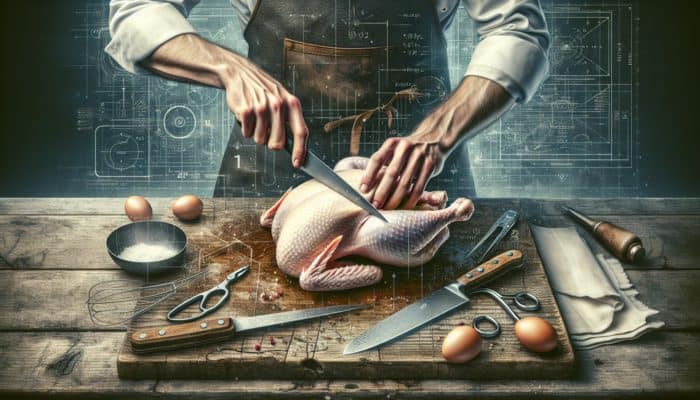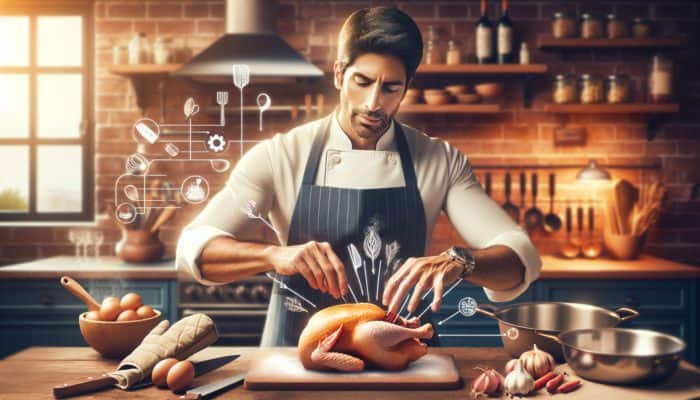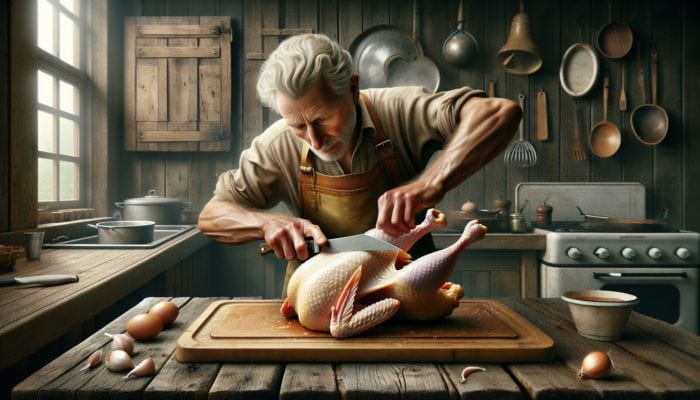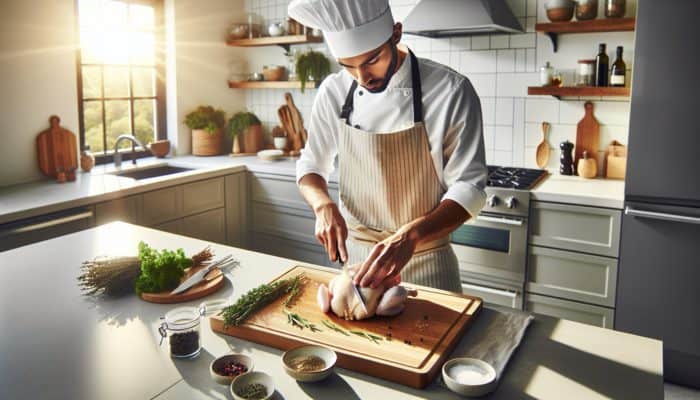Master the Art of Butterflying Chicken for Perfectly Cooked Meals
What Exactly is the Butterflying Technique?

How to Butterfly a Chicken for Even Cooking: Butterflying, often referred to as spatchcocking, is a culinary technique that involves flattening poultry, such as chicken, to achieve even cooking. This process requires removing the backbone of the bird and pressing it flat, which allows the meat to cook uniformly on all sides. This method is highly regarded by both professional chefs and home cooks for its ability to enhance cooking efficiency and improve the presentation of the dish. To successfully butterfly a chicken, a few essential tools are necessary for optimal results.
- Sharp kitchen shears
- Boning knife
- Sturdy cutting board
- Meat mallet (optional)
- Paper towels for drying
- Marinade or seasoning of choice
- Meat thermometer (for cooking)
Gaining an understanding of the basics of butterflying provides a solid foundation for ensuring your chicken is cooked evenly, resulting in juicy, tender meat complemented by irresistibly crispy skin. This versatile technique is not limited to chicken alone; it can also be applied to various types of poultry, thereby expanding your culinary repertoire and enhancing your cooking efficiency in the kitchen.
Why is Butterflying a Game-Changer in Cooking?
Choosing the butterflying technique can transform your cooking experience in numerous ways. Primarily, butterflying a chicken dramatically reduces cooking time, often cutting it by up to half. This is particularly advantageous for busy households seeking to prepare delicious meals without spending excessive time in the kitchen. Moreover, this method guarantees even cooking, which allows for better distribution of flavours and juicier results—two critical elements in crafting a delectable dish.
The adaptability of butterflied chicken extends beyond mere cooking time and even cooking. It can be tailored to various cooking methods, such as grilling, roasting, or broiling, each of which brings a unique flavour profile to the table. By exposing more surface area to heat, you unlock the potential for rich caramelisation and crispy skin, both of which are highly sought after in culinary circles. Ultimately, butterflying simplifies the cooking process while elevating the overall quality of your dishes, making it a must-try technique for all cooking enthusiasts.
Can You Apply the Butterflying Technique to Other Poultry Types?
Absolutely! While butterflying is most commonly associated with chicken, this versatile method can also be applied to a range of other poultry, including ducks and turkeys. However, certain adjustments in technique may be necessary due to the size and structure of these birds. For instance, duck typically has a thicker layer of fat, which may necessitate additional cooking time or specific seasoning approaches to achieve a perfectly succulent dish.
When butterflying a turkey, the process is akin to that of a chicken but requires more strength due to the bird's larger size. A larger cutting board and potentially a more robust toolset, including a larger boning knife or heavy-duty kitchen shears, can facilitate this task. Regardless of the type of poultry you opt to butterfly, mastering this skill can elevate your cooking game and impress your guests, making it a valuable endeavour for any culinary enthusiast.
Expert Guidance on Butterflying Chicken for Consistent Cooking

What Steps Should You Follow to Butterfly a Chicken?
The process of butterflying a chicken is both straightforward and rewarding, primarily involving three key steps: removing the backbone, flattening the bird, and optionally tucking the wings. With a bit of practice and attention to detail, you can master this technique, ensuring that you achieve perfect butterflied chicken each time.
To efficiently butterfly a chicken, follow these detailed steps:
- Position the chicken breast-side down on a sturdy cutting board.
- Utilising sharp kitchen shears, cut along each side of the backbone to remove it entirely.
- Discard the backbone or set it aside for making stock.
- Flip the chicken over and press down firmly on the breastbone to flatten the bird.
- Optionally, tuck the wings beneath the body to prevent them from burning during cooking.
- Pat the chicken dry with paper towels to ensure maximum crispness when cooking.
- Generously season the chicken, allowing flavours to penetrate the meat.
By adhering to these steps, you can create a beautifully butterflied chicken ready for various cooking techniques. This method not only enhances cooking efficiency but also ensures an impressive presentation sure to delight diners.
How Can You Achieve a Clean Cut When Butterflying?
Achieving a clean cut while butterflying a chicken is crucial for a successful result. Using sharp kitchen shears or a boning knife is essential for this task; dull tools can lead to torn skin and uneven cuts, negatively impacting both presentation and cooking quality. Positioning the chicken breast-side down enables easy access to the backbone, simplifying the cutting process.
To ensure a clean cut, firmly grip the chicken and confidently cut along each side of the backbone. It's important to take your time and follow the natural contours of the bird. A well-honed knife or shears will glide smoothly through the bone and flesh, creating a neat separation. Regularly maintaining your tools, including honing and sharpening, is necessary to achieve optimal results in your cooking.
In addition to employing sharp tools, the preparation of the chicken itself plays a significant role in ensuring clean cuts. A dry chicken allows for better grip and reduces slippage, contributing to precision in cutting. The combination of quality tools and proper technique will lead to a successful butterflying experience, setting the stage for deliciously cooked poultry in your kitchen.
What Common Mistakes Should You Avoid When Butterflying?

When butterflying a chicken, several common mistakes can compromise the final result. Avoiding these pitfalls will not only enhance your skills but also improve your cooking outcomes. One frequent error is not cutting close enough to the backbone, which can leave parts of the spine attached, making it difficult to flatten the chicken and hindering even cooking.
Another common mistake is failing to flatten the bird adequately. If the chicken is not pressed down sufficiently, it may cook unevenly, resulting in undercooked areas or dry pieces. Take the time to ensure the bird is fully flattened, as this step is vital for optimal cooking. Additionally, tearing the skin while cutting can mar the presentation and lead to moisture loss during cooking.
In real-world cooking scenarios, inexperienced cooks often rush through the butterflying process, leading to these mistakes. By taking a deliberate approach, focusing on precision, and aiming to improve with each attempt, you will yield better results over time. By being mindful of these common pitfalls, you can refine your technique and enjoy consistently delicious butterflied chicken in your meals.
Essential Steps to Prepare Your Chicken for Butterflying
How Should You Properly Prepare the Chicken?
Proper preparation of the chicken before butterflying is crucial for achieving optimal results. Start with a fully thawed chicken, as attempting to butterfly a frozen bird can be both challenging and unsafe. Ensure the chicken is completely thawed in the refrigerator for safe handling. Begin by removing any giblets from the cavity, which are often included in the packaging.
Once you have removed the giblets, pat the chicken dry with paper towels. This step is crucial, as a dry surface allows for better handling and ensures that the skin crisps up beautifully during cooking. Additionally, maintaining a clean workspace contributes to the efficiency of the process, so consider wiping down your cutting board and tools before starting.
It's also wise to have all your tools within reach and ready to use. A sharp knife, sturdy cutting board, and kitchen shears should be prepared for the task at hand. Having everything organised will streamline the process and minimise the risk of accidents in the kitchen. Effective preparation not only simplifies the task but also sets the stage for a successful butterflying experience that leads to delicious meals.
Should You Season the Chicken Before or After Butterflying?
The question of whether to season before or after butterflying a chicken is commonly posed among cooks. For optimal flavour, it is advisable to season the chicken before the butterflying process. This allows the flavours to penetrate the meat more effectively, enhancing the overall taste during cooking. Applying seasoning to both the skin and flesh promotes better flavour distribution throughout the bird.
To ensure that the seasoning adheres well, consider using a mixture of salt, pepper, and any desired herbs or spices. Evenly rub the seasoning over the entire chicken, paying attention to both the skin and the exposed flesh. This approach will lead to a more flavourful result, as the marinated chicken will absorb the seasonings while it cooks.
Alternatively, you may choose to butterfly the chicken first and then marinate it in your preferred seasoning blend. While this method can also yield good results, allowing the chicken to marinate before butterflying typically provides deeper flavour profiles. Experimenting with both methods can help you determine which works best for your cooking style and personal taste preferences.
What Tools Are Indispensable for Butterflying?
Having the right tools is essential when it comes to butterflying a chicken. Key tools include sharp kitchen shears or a boning knife, both of which are crucial for cutting through the backbone cleanly. A sturdy cutting board is also vital, as it provides a stable surface for working with raw poultry. Ensuring that your cutting board is large enough to accommodate the entire chicken will aid in the butterflying process.
Additionally, a meat mallet can help flatten the bird once the backbone has been removed. While not strictly necessary, it can help achieve a uniform thickness for even cooking. Paper towels are vital for drying the chicken, allowing for better seasoning and crispness during cooking.
Finally, a meat thermometer should be within reach to check the internal temperature of the chicken as it cooks. This tool is critical for ensuring that the bird is cooked through without overcooking, resulting in juicy, tender outcomes. Having these tools organised and ready before beginning the butterflying process will facilitate a smoother experience and lead to delicious results in your kitchen.
How Long Should You Marinate the Chicken Before Butterflying?
Marinating chicken before butterflying it can significantly enhance its flavour. For optimal results, marinate the chicken for at least 30 minutes. This timeframe allows the flavours to begin penetrating the meat, providing a more savoury experience. However, for those seeking truly extraordinary flavour, marinating the chicken overnight is highly recommended. This extended marination period not only amplifies taste but also helps tenderise the meat, resulting in a juicy final product.
When marinating, consider using a mixture of oils, acids (such as lemon juice or vinegar), herbs, and spices that complement your cooking method. Ensuring the marinade evenly coats the chicken is essential for achieving consistent flavour distribution. A resealable bag or a deep dish can be suitable for marinating, allowing for ease of handling and cleanliness.
Once the marinating time is complete, proceed to butterfly the chicken as instructed. The added flavour from the marinade will enhance the cooking experience, creating a mouthwatering dish that delights the palate. Exploring different marinades can lead to a variety of unique and delicious results, making every cooking session an opportunity for culinary exploration.
Can You Butterfly a Frozen Chicken?
Butterflying a frozen chicken is not advisable due to safety concerns and the difficulty of the task. Attempting to cut through frozen meat can lead to accidents, and the results are often unsatisfactory. Instead, it is crucial to thaw the chicken completely before attempting to butterfly it. Thawing allows for better handling, ensuring that the chicken remains stable while cutting.
For safe thawing, place the chicken in the refrigerator for several hours or overnight, depending on its weight. This method allows the meat to thaw evenly without compromising its texture or safety. Alternatively, you can use the cold water method, where the chicken is submerged in cold water in its packaging, changing the water every 30 minutes until fully thawed.
Once the chicken is thawed, you can proceed with the butterflying process as outlined. Ensuring that the chicken is at the appropriate temperature not only makes the cutting easier but also contributes to a better overall cooking experience. Investing time in the thawing process will lead to delicious and safely prepared meals for you and your family.
Cooking Techniques to Perfect Your Butterflied Chicken
What Are the Best Cooking Methods for Butterflied Chicken?
When it comes to cooking butterflied chicken, various methods can elevate your dish, each offering unique flavours and textures. Grilling is one of the most popular methods, as it imparts a delightful smokiness and allows the skin to crisp up beautifully. The direct heat of the grill cooks the chicken evenly, making it an optimal choice for outdoor cooking enthusiasts seeking a delicious meal.
Roasting is another excellent technique for cooking butterflied chicken. By placing the chicken in a preheated oven, you create an environment that promotes even cooking while allowing the skin to crisp up. Roasting at a high temperature can yield remarkable results, creating a golden-brown exterior while retaining the meat's juiciness and tenderness.
Broiling presents a third option, particularly effective for those seeking a quicker cooking time. This method directs high heat at the chicken from above, allowing for rapid cooking and the development of a crispy skin. Broiling is especially useful when you need to create a delicious meal in a short amount of time, making it a fantastic option for busy cooks.
Regardless of the method you choose, the key to success lies in monitoring cooking times and internal temperatures. With butterflied chicken, you can enjoy a variety of cooking techniques that enhance flavour and presentation, making each meal a delightful experience for you and your guests.
How Does Cooking Time Change with Butterflying?
Butterflying a chicken significantly reduces cooking time, making it an efficient method for busy cooks. When the chicken is flattened, the surface area exposed to heat increases, allowing for faster and more even cooking. In fact, cooking time for butterflied chicken can often be reduced by up to half compared to traditional roasting methods.
For example, a whole chicken typically requires around 1.5 to 2 hours to roast at 180°C (350°F). However, a butterflied chicken may only take around 30 to 45 minutes, depending on the size and cooking method used. This reduction in cooking time can be particularly beneficial for weeknight dinners or last-minute meal preparations when time is of the essence.
While the reduced cooking time is advantageous, it remains essential to monitor the internal temperature of the chicken closely. Using a meat thermometer will help ensure that the thickest part of the chicken reaches at least 75°C (165°F) to guarantee food safety. This method not only saves time but also simplifies meal prep, allowing you to serve delicious, juicy chicken with crispy skin in less time than traditional cooking methods.
Can You Achieve Crispy Skin with Butterflied Chicken?
Achieving crispy skin on butterflied chicken is entirely possible and often results in a more flavourful dish. The key to attaining that desired crispiness lies in the exposure of the skin to heat. When the chicken is flattened, more surface area is available for direct contact with the heat source, promoting optimal browning and crisping.
To further enhance crispiness, consider patting the skin dry with paper towels before seasoning. Removing excess moisture allows for better caramelisation during cooking. Additionally, employing a high-temperature cooking method, such as grilling or roasting at a high heat, encourages the skin to crisp up beautifully, creating a delightful texture contrast.
Consider using a marinade or dry rub containing sugar, as sugar promotes browning and can enhance crispiness. When combined with a hot cooking environment, this can lead to a wonderfully crunchy exterior. By employing these techniques, you can enjoy the benefits of butterflied chicken, including perfectly crispy skin that makes every bite a joy to savour.
Advanced Strategies for Perfectly Butterflied Chicken
What Are Some Advanced Butterflying Techniques to Elevate Your Cooking?
Once you've mastered the basic technique of butterflying a chicken, consider exploring advanced strategies that can elevate your culinary skills. One such technique involves scoring the skin before cooking, which entails making shallow cuts in the skin. This allows fat to render out more effectively, resulting in extra crispy skin and enhanced flavour in your dish.
Another advanced strategy is marinating the chicken before butterflying. By allowing the flavours to penetrate the meat while it remains whole, you enhance the overall taste of the dish. Once you butterfly the chicken, you can apply additional seasoning to the exposed areas for maximum impact and flavour infusion.
Utilising diverse seasonings, such as a dry rub or a wet marinade, can also create distinct flavour profiles. Experimenting with various herbs, spices, and aromatics will allow you to customise your butterflied chicken to suit your preferences or align with specific cuisines from around the world. Each technique not only enhances flavour but also contributes to a beautifully cooked chicken that leaves a lasting impression on dinner guests.
Understanding the optimal timing for applying these advanced techniques can significantly improve your culinary results. They can transform a simple butterflied chicken into a spectacular dish that showcases your skills and creativity in the kitchen, impressing anyone fortunate enough to taste your creations.
How Can You Ensure Even Cooking for Butterflied Chicken?
Ensuring even cooking is crucial for achieving optimal results when butterflying chicken. One of the most effective methods is to use a meat thermometer. By checking the internal temperature at the thickest part of the chicken, you can ensure that it reaches the safe cooking temperature of 75°C (165°F). This tool provides accurate readings and helps you avoid undercooked or overcooked sections of the meat.
If grilling, rotating the chicken halfway through cooking can promote even cooking throughout. Positioning the bird correctly on the grill to avoid hot spots—areas that cook faster—contributes to uniform cooking. It's advisable to monitor the chicken closely, adjusting its position as needed to ensure all parts are cooked evenly and to perfection.
Using a brine is another strategy that can help maintain moisture and promote even cooking. Brining the chicken for several hours before cooking not only enhances flavour but also helps retain juiciness during the cooking process. By implementing these strategies, you can achieve perfectly cooked butterflied chicken that is both tender and flavourful, impressing anyone fortunate enough to enjoy it.
What Are Expert Tips for Achieving Perfect Butterflied Chicken?
To achieve the best possible results when butterflying a chicken, expert tips can make a significant difference. One suggestion is to practice on smaller birds, such as Cornish hens, which can help you refine your technique before tackling larger poultry. This approach allows you to build confidence and improve your skills with less waste and fewer challenges.
Another tip is to take your time during the butterflying process. Rushing can lead to mistakes and messy results. A steady hand and a calm approach will yield cleaner cuts and better presentation. Remember to focus on the details, ensuring that the backbone is removed thoroughly and that the bird is flattened evenly for optimal cooking results.
Additionally, consider the importance of marination and seasoning. Experts recommend experimenting with a variety of flavour combinations to discover what suits your palate best. Keeping notes on successful marinades can help you replicate your best dishes in the future. By incorporating these expert tips into your cooking practices, you can develop your skills and create consistently excellent butterflied chicken that impresses every time.
What Tools Are Necessary for Butterflying a Chicken?
When undertaking the task of butterflying a chicken, the right tools are essential for achieving a successful outcome. Sharp kitchen shears or a boning knife are essential for cleanly cutting through the backbone, enabling precise control during the process. Investing in high-quality tools will make a noticeable difference in your ability to butterfly poultry effectively and safely.
A sturdy cutting board is equally important, as it provides a stable surface for cutting. Opting for a larger board allows you to manoeuvre the chicken more easily, reducing the risk of accidents. Having paper towels on hand for drying the chicken is also beneficial for ensuring that the skin crisps up beautifully during cooking.
Lastly, a meat thermometer is an indispensable tool for monitoring the doneness of meat. This device will help you achieve a perfectly cooked chicken, ensuring that it reaches the appropriate internal temperature without overcooking. By having these essential tools readily available, you can streamline the butterflying process and enjoy a more successful cooking experience in your kitchen.
Exploring the Benefits of Butterflying a Chicken
Does Butterflying Save Time in the Kitchen?
One of the primary benefits of butterflying a chicken is the significant time savings it offers during cooking. The flat shape allows for quicker and more efficient cooking, often reducing the required time by nearly half compared to traditional roasting methods. This time efficiency is particularly beneficial for busy weeknights when you need to prepare a delicious meal without spending hours in the kitchen.
In addition to saving time, butterflying simplifies the cooking process. The increased surface area exposed to heat enhances flavour development and allows for faster browning. This means you can serve mouthwatering, crispy-skinned chicken in a fraction of the time, making it a favoured choice among home cooks and professional chefs alike who appreciate efficiency in their cooking.
Ultimately, this technique not only saves time but also enhances your cooking experience. You can focus on enjoying the meal with family and friends rather than spending all your time preparing it. By incorporating butterflying into your cooking repertoire, you can create delicious meals that fit your busy lifestyle while maintaining quality and flavour.
Can Butterflying Enhance the Flavour of Chicken?
Butterflying a chicken can significantly elevate its flavour profile. By flattening the bird, you increase the surface area that comes into contact with seasonings and marinades. This allows flavours to penetrate deeper into the meat, resulting in a more savoury and satisfying eating experience that impresses with each bite.
Moreover, the even cooking achieved through butterflying contributes to a more consistent flavour distribution. As the chicken cooks, the first layer of flavour, such as marinades or dry rubs, is enhanced by the caramelisation of the skin. This combination creates a harmonious balance of taste and texture that is hard to replicate with traditional cooking methods, ensuring your dish stands out.
Experimenting with various marinades and seasonings can further elevate the flavour of your butterflied chicken. Different herbs, spices, and aromatics can be utilised to create diverse flavour profiles that cater to various palates and culinary styles. By harnessing the benefits of butterflying, you can unlock a world of culinary possibilities and consistently enjoy delicious, flavourful chicken at every meal.
Is Butterflying a Cost-Effective Cooking Method?
Butterflying a chicken can indeed be a cost-effective cooking method, maximising the use of the entire bird while delivering impressive results. By opting for butterfly, you are not only getting the most out of each chicken but also bypassing the need for expensive cuts of meat. Whole chickens are often more economical than pre-cut portions, allowing you to save money while still serving a delicious meal to your family or guests.
Furthermore, the technique can lead to less waste. When you butterfly a chicken, you can use the removed backbone to create flavourful stock or broth, effectively reducing food waste while enhancing your culinary repertoire. This practice not only saves money but also allows you to utilise every part of the bird effectively, demonstrating resourcefulness in the kitchen.
By adopting butterflying as a standard practice in your cooking, you can enjoy both delicious meals and financial savings. This approach to cooking encourages creativity and resourcefulness, making it a worthwhile investment for any home cook looking to maximise their culinary capabilities while being mindful of costs.
Best Practices for Storing and Reusing Butterflied Chicken
How Should You Properly Store Leftover Butterflied Chicken?
Properly storing leftover butterflied chicken is crucial for maintaining its freshness and flavour. After cooking, allow the chicken to cool before transferring it to an airtight container. When stored correctly, leftover butterflied chicken can be kept in the refrigerator for up to four days, allowing you to enjoy your delicious meal multiple times without compromising its quality.
If you need to store the chicken for a longer period, consider freezing it. Wrap the chicken securely in plastic wrap or aluminium foil, and place it in a freezer-safe bag or container. When stored this way, butterflied chicken can remain frozen for up to three months without losing its quality, allowing you to enjoy your cooked dish at a later date.
When reheating leftover chicken, be mindful of maintaining moisture. You can do this by adding a splash of broth or water to the container before microwaving or reheating in the oven. By following these storage tips, you can enjoy the convenience of leftover butterflied chicken while preserving its flavour and quality for future meals that delight your taste buds.
Can You Reuse the Backbone for Other Culinary Purposes?
Yes, the backbone removed during the butterflying process can be reused to create a rich and flavourful stock or broth. This practice is not only economical but also a clever way to extract additional flavour from the entire chicken. By simmering the backbone with vegetables, herbs, and spices, you can create a base for soups, stews, or sauces that enhances the overall flavour of the dish.
To make stock using the backbone, start by placing it in a large pot along with aromatics such as onions, carrots, celery, and herbs like thyme or bay leaves. Cover the ingredients with water and bring to a boil, then reduce the heat to a simmer. Allow the stock to cook for several hours, skimming off any impurities that rise to the surface to ensure a clear and flavourful liquid.
Once the stock reaches your desired flavour, strain it through a fine-mesh sieve to separate the liquid from the solids. The resulting homemade stock can be used immediately or stored in the refrigerator for a few days or frozen for longer-term use. This practice maximises the use of the chicken and contributes to a sustainable cooking approach, making it an excellent choice for resourceful home cooks who appreciate efficient kitchen practices.
What Are Creative Ways to Use Leftover Butterflied Chicken?
Leftover butterflied chicken offers numerous creative possibilities, allowing you to transform yesterday's meal into exciting new dishes. One popular option is to chop the leftover meat and incorporate it into salads. Tossing the chicken with greens, vegetables, and a zesty dressing creates a refreshing meal that's perfect for lunch or a light dinner while being nutritionally balanced.
Another idea is to use the leftover chicken in sandwiches or wraps. Pairing the meat with fresh ingredients like avocado, lettuce, and a spread such as mayo or hummus creates a satisfying lunch option that is quick and easy to prepare. The versatility of butterflied chicken also lends itself well to soups. Shred the meat and add it to a pot of broth with vegetables and spices for a comforting and hearty meal that warms the soul.
For those feeling adventurous, consider using the leftover chicken in international dishes, such as chicken tacos or stir-fries. The adaptability of butterflied chicken makes it an excellent ingredient for a variety of cuisines, enabling you to explore new flavours and cooking techniques. By exploring different ways to use leftovers, you can enjoy delicious meals while minimising waste and maximising flavour, making each cooking session an opportunity for culinary creativity.
Frequently Asked Questions
What is the best way to butterfly a chicken?
The best way to butterfly a chicken is to use sharp kitchen shears to cut along each side of the backbone, remove it, and then press down firmly on the breastbone to flatten the bird evenly.
Can I butterfly a chicken without special tools?
While it’s easier with kitchen shears or a boning knife, you can use a sharp chef's knife to butterfly a chicken. The key is ensuring your tools are sharp enough to make clean cuts without tearing the meat.
How long does it take to butterfly a chicken?
Butterflying a chicken typically takes around 10 to 15 minutes, depending on your skill level and the tools you’re using for the task.
Is it necessary to marinate a chicken before butterflying?
It's not strictly necessary, but marinating before butterflying can enhance flavour. If you prefer deeper flavour penetration, marinating first is generally recommended for the best results.
Can I butterfly a chicken that is not fully thawed?
No, it's not safe to butterfly a chicken that is not fully thawed. Always ensure the chicken is completely thawed for safe handling and even cutting during the butterflying process.
What internal temperature should butterflied chicken reach?
Butterflied chicken should reach an internal temperature of at least 75°C (165°F) to ensure it is cooked through and safe to eat, providing peace of mind while enjoying your meal.
Can I grill butterflied chicken on a charcoal grill?
Yes, grilling butterflied chicken on a charcoal grill adds a delicious smoky flavour. Ensure the grill is preheated and monitor cooking times closely for even results that please the palate.
What is the best way to store leftover butterflied chicken?
Store leftover butterflied chicken in an airtight container in the refrigerator for up to four days, or freeze it for longer-term storage to enjoy at a later date.
Can I use the backbone for anything after butterflying?
Yes, the backbone can be used to make stock or broth, adding richness and flavour to soups or sauces, maximising the use of the chicken and reducing waste in your kitchen.
What are some creative ways to use leftover butterflied chicken?
Creative uses for leftover butterflied chicken include salads, sandwiches, tacos, or stir-fries, allowing for a variety of tasty meals while minimising waste and maximising flavour in your cooking.


